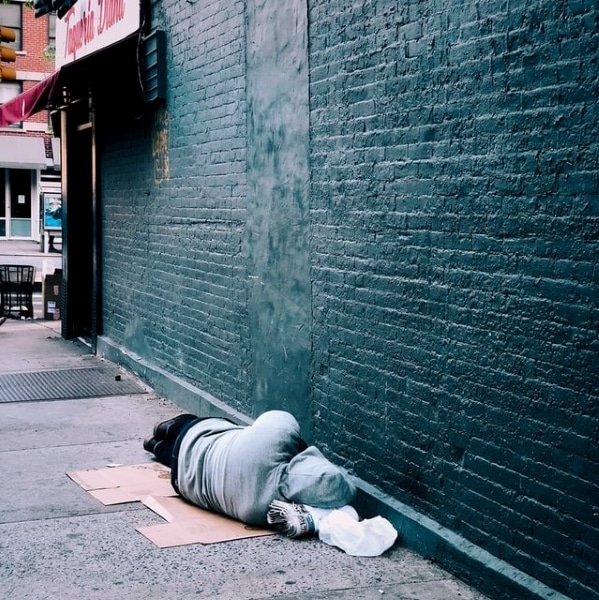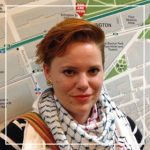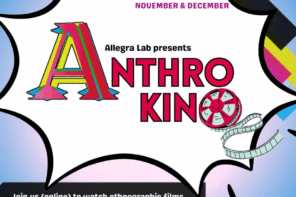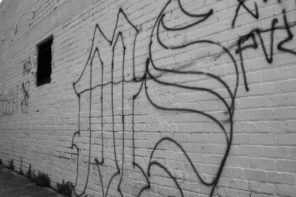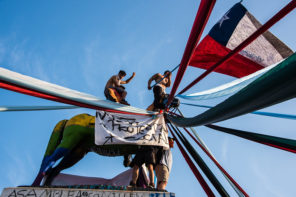“Miss Nina, time to wake up! First bus leaves in half an hour!”
Nina opened her eyes halfway, and nodded assent.
“OK honey, I’ll check on you in a few minutes,” Laura replied. Or maybe her name was Jean, or Miriam. All of the social workers at Thibault Memorial City Shelter, also known as “Teebo”, or just “the shelter”, knew Nina’s name by now, but she couldn’t seem to keep them straight. This one was one of the nicer ones though. She would let you sleep a few minutes past wake-up. Some of the others would scream in your ear or pull your blankets off if you were still in bed after 5:30am.
As soon as the social worker moved away, Nina buried her head between her pillow and the flimsy, plastic-coated mattress. If she could eke out a few more minutes of sleep, might as well try.
––––
By 6:15am, Nina had grudgingly gotten out of bed, dressed, stood in line for ten minutes to pee, wash her face and brush her teeth, and had stripped her mattress of the used blankets, sheets and pillow. Some of the other women were mopping the floors or wiping down beds, chores that they were not paid for but would earn them a cup of coffee from Laura/Jean/Miriam. Nina badly wanted a cup of coffee but scrubbing toilets in exchange for a weak brew with powdered milk still felt too undignified, especially before the sun was even fully up. She slipped outside to wait for the bus back to the Teebo building downtown and smoke her first cigarette of the day.
The original Teebo building was in the middle of the city, just a few minutes from the football stadium and the city hall and the outdoor shopping mall, an open plaza ringed with designer handbag boutiques and imported wine stores. There was a time when Nina had gotten quite good at nabbing a bottle or two from those stores, but now the mall was too full of police and cameras for her to try.
The bus pulled up, a worn-out, old school bus that read “Municipal Directorate of Human Services” on the side. These days, more and more people were stealing wine and begging for change downtown, and the original Teebo was getting dangerously overcrowded. So, the “Municipal Directorate of Human Services” had leased a space in the industrial district, and every night from 6:00–8:30pm they bussed 200 homeless women out of the city and into a big building that they called an “overflow shelter”.
This short story offers a street-level view of a city in the midst of both economic growth and a population boom, but a city that has also neglected its long-term residents in order to make ways for luxury tourists and a new generation of urban professionals.
A “human warehouse” is what Nina called it. As the bus pulled out, they drove past other storage facilities, fish-packing plants, chop-shops, parking lots full of eighteen-wheel trucks. This part of town was where you put things that you didn’t need, the perfect place to put panhandlers, shoplifters and anyone else who was priced out of a hometown.
Nina felt an urge to smoke another cigarette. Instead, she pulled a marker out of her bag, doodling on the back of the seat in front of her.
Nina was here
She retraced the letters absentmindedly, until they were about to pull into the original Teebo parking lot. Then she scribbled out her name, just in case the driver saw it and reported to the shelter that someone named Nina was destroying municipal property.
████ was here
She shoved her marker back into her bag and checked under the seat before she got off the bus. She couldn’t afford to leave anything behind, not even a name doodled on a headrest.
––––
Breakfast, consisting of more weak coffee, toast and fruit salad, was over by 8:00am. That meant at least five or six hours until she could expect to start her usual enterprise, of drawing quick caricature portraits of tourists or of couples celebrating their three-month anniversary. She had nothing to do until then, and she knew already that she would work better if she could sleep for a few more hours. She weighed her options as she smoked another cigarette. One could try and sleep on the lawn outside of the Teebo building, but everyone knew you risked getting your backpack snatched there. There were also a handful of parks within walking distance. When Nina was younger, and she felt the need to spend a night or two away from her Dad and her stepmom, she had crashed on a park bench. Only these days the benches had been replaced with individual stainless-steel chairs that were bolted down, and just like in the downtown mall, police were patrolling them much more regularly. The public library was usually your best bet for an undisturbed, daytime snooze, but the nearest branch was temporarily closed for renovations.
Eventually, she wandered by the stadium. There were a series of alcoves built into the exterior wall, where one could have a modicum of privacy if you were lucky, and today she was. The third alcove Nina inspected was empty, and she dropped to the pavement, wedged her bag into a corner, and curled up against it to snatch a few more hours of rest.
It felt like only a few minutes had gone by when she suddenly felt a shock run from the sole of her foot up her whole body. She gritted her eyes closed, but again something knocked, hard against the bottom of her shoe, rattling her whole leg. When she opened her eyes, it took a moment to adjust to the sun, and she made out the shape of a security guard, who was in the process of drawing his heavy boot back to kick her in the feet again. She scrambled halfway upright, drawing her legs into her chest before he could kick her again.
“Come on, street rat, get up and get out,” the guard growled.
“It’s only for a few hours!”
“Don’t care. There’s a game today, and that means we gotta get this place cleaned up. No trash lying around.” He tapped his boots against the pavement and rested his thumbs on his utility belt. Nina noticed a nightstick hanging from the side of the belt, inches from his hands. When the guard saw her staring at his weapon, a slow grin spread over his face. She decided that it might be a good idea to take off.
The protagonist, Nina, feels alienated in a city that has been redesigned to render homeless and working-class people invisible, or, when possible, to remove them entirely from the city centre.
It was still early, but Nina was feeling a lot less sleepy, and she felt the need to get away from the stadium and the security guard. She headed west, away from downtown and across the river to the Edgewater District. When she was little, when the city was really more of a town, and the Teebo Human Warehouse had not yet been built, Edgewater was the industrial part of town, a place full of mechanics shops and canning factories and cobbled-together housing where you could be sure that two or three families were squeezed into every apartment. But at some point, the canning factory had been converted into loft apartments, and the apartment buildings had been bulldozed to make office buildings. Some of the mechanics shops were still mechanics shops, but others had been turned into bars, or in one case converted into the offices and printing press of the biweekly Edgeside Arts Digest, a newsletter that featured interviews with burlesque dancers and slam poets and held annual cartoon contests. Nina had entered the cartoon contest twice, but after her work was rejected a second time, she hadn’t bothered again.
There was a small crowd clustered around the Edgeside Arts Digest building today. When Nina got close, she could see the crowd was watching an artist as she threw, sprayed and slapped paint along the side of the building. She had a transfixing way of working, jumping around on ladders and bits of scaffolding, adding a bit of the picture here, and another there, and slowly letting the image emerge of a trio of tuxedo-clad musicians playing guitar and violins and singing, surrounded by dancing couples and families with smiling children. Nina watched, at first transfixed, and then slightly jealous as she thought of how this woman was openly decorating a two-story building in broad daylight while she’d to scratch her name off the bits of graffiti she’d left on a bus seat this morning…
Then Nina shook herself mentally, recognizing that the growing crowd constituted a good opportunity for her to make some money. She found a place to sit, and pulled out her sketchbook, markers and carefully preserved “Caricatures: $5, Five Minutes” sign and waited for customers to roll up.
––––
By the time night had fallen, and the artist had finished painting for the day, Nina had sold enough drawings to buy a double bacon cheeseburger, a six pack of beer, and fresh art supplies, and still have some cash left over. She lingered late near the half-finished mural, sipping her beer from a paper bag, even though she knew it meant missing the bus back to the shelter for the night. The day had left her with an itchy feeling in the pit of her stomach, the sort of sensation that portended a sleepless night. So instead of the promise of a bed, she gnawed on her burger and attacked the mural with her eyes.
The picture was beautiful, she thought, though hardly a great and profound work of art. And that rankled her. No matter how much she enjoyed the colors, no matter how she could envision the next steps of the dancers or hear the beat of the music, it seemed too simple, too digestible, too inoffensive to deserve free rein over the side of a whole building. Too meaningless to live up to the stylized, spray-painted, street art style. The more she looked at it, the more annoyed she became. This was art for people who lived in converted lofts, drank imported wine and shopped at designer handbag boutiques, not art for people who slept in a giant room with hundreds of other people and had to beg or steal to get necessities.
How dare this woman with so much talent, with such a canvas, waste it all? If only she could have such a space to work… She would fill it with pictures of children hanging out the windows of rickety apartment buildings, parks full of people napping on benches and mechanics sipping drinks together after the end of a workday, grease-stained and foul-mouthed and cheerful.
Nina stood up quickly and pushed her remaining cans of beer into her backpack. Thinking like this wouldn’t get her anywhere. Yet, as she tore her eyes away from the mural, Nina noticed that some of the paints that the artist had used were still sitting out, forgotten for the time being. She stalked over and quickly picked up a can of spray paint. It was still half full. She stuffed it into her backpack as well. Then she grabbed the remaining cans. There were more left over, but she didn’t have space to conceal them all.
Cradling her pilfered paint cans and glancing over her shoulder, Nina turned back the way she had come that morning. Being homeless in a city like this had given her plenty of experience in making herself scarce when necessary, but the discomforting feeling of running away was a lot to bear twice in one day. At least she had chosen it the second time around. Or had she? Stealing the paints had felt less like a choice, and more of a compulsion. Anyway, it was less stealing, and more rebelling against the pleasant but impersonal, this impostor mural artist?
Her turn to street art is an attempt to make herself relevant again in the social fabric and daily discourse of the city. Her actions are both inspired by and in spite of the laws, property rights and economic norms that have removed her from common space.
No, it was stealing, but all the same Nina relaxed by the time she had made it across the river. No one seemed to have seen her swipe the cans, and she knew from experience the police wouldn’t follow up on a such as petty theft as some half-empty bottles of spray paint. She relaxed momentarily, then contracted again when she caught sight of the stadium. It was late now, the game was over, and the security shift would have changed. Still, she imagined the guard she had encountered earlier stalking around each corner, brandishing his nightstick.
She steeled her shoulders and forced herself to make the pragmatic decision. As long as the stadium was quiet, it was still the best place to hunker down for the night. The alcove where she had sought shelter earlier was still empty, and she lay down, resting her head again on her backpack. But tired as she was, sleep wouldn’t come. She was too tense, remembering the security guard kicking her awake, too annoyed at what she thought was a pretty waste of a wall on the side of the Edgeside Arts Digest building, and she couldn’t get comfortable against the clanking cans of beer and paint in her bag. She pulled them out, cracked open another beer. Then she started painting.
It took the better part of the night to get the hang of the spray paint, to figure out how to layer the colours, and to decide exactly what she wanted to leave behind, but just before the sun came up, the wall of the stadium now had “████ was here” painted in letters that were almost as tall as a person.
Nina grinned. Even if anyone else saw a yawning black space where a word should be, she could always see that the writing there was for her, a tiny mark of permanence, of ownership on the walls of a city that barely seemed to tolerate her. After all, who better to be represented by a black and empty box than her?
––––
“████ was here” tags soon proliferated all over the city, in alleys behind shops selling designer handbags and imported wine, on fish-packing plants, the Thibault Memorial City Shelter, mechanics shops and even on the side of a Municipal Directorate of Human Services bus. Sometimes, other people would paint it in later, adding their own names in the empty black space. #BlankWasHere racked up hits on Instagram. After a few months the Edgeside Arts Digest even ran a cover story under the title “The Mystery Artist Was Here”, which speculated which of three prominent local artists might have been the graffitist behind the series of “interactive art that invites the viewer to question the anonymous nature of the city, of the passer-by who may carry a dark but beautiful secret”. The Edgeside Arts Digest article did not consider that a homeless caricaturist who had not been featured in its cartoon competitions might be the responsible party.
Shortly after the article was published, though, the Edgeside Arts Digest staff were shocked to find that “Songs of Summer”, the commissioned mural on the side of their own building, had been partly covered by the words “ was here”…
Explanatory appendix
This story was inspired partly by David Harvey’s article on “The Right to the City”, International Journal of Urban and Regional Research, 27(4): 939-41 (2003), partly by Robert Rosenberger’s article “On hostile design: Theoretical and empirical prospects”, Urban Studies, 57(4): 883–893 (2020), and partly by my own experience working in emergency homeless shelters in Denver, Colorado, and Boston, Massachusetts (USA). My short story offers a street-level view of a city in the midst of both economic growth and a population boom, but a city that has also neglected its long-term residents in order to make ways for luxury tourists and a new generation of urban professionals. The protagonist, Nina, feels alienated in a city that has been redesigned to render homeless and working-class people invisible, or, when possible, to remove them entirely from the city centre. For Nina, this means being separated from the fabric of a city where she has lived her entire life. Finally, one night she turns to art in order to remind herself that she is a resident of this city, and to leave her mark on it. To her surprise, her artistic vision is celebrated so long as its origins remain anonymous. Emboldened, she again uses her signature art to occupy space that she feels has been squandered on lesser art, and finally claims credit for her own statement.
The everyday challenges that Nina faces in considering where to take a nap, the correlation not only between design choices that prevent her from being able to use public space, but also to the increased security presence in the city, and the way in which she feels that she is being actively removed from visible areas of her hometown, are all reflections of points that Rosenberger makes in his article. However, the trend of relocating homeless shelters and populations from city centres into industrial areas or working-class suburbs was as trend I saw replicated during my own time as a social worker, and seemed to be the logical conclusion of both the private and public hostile design choices that Rosenberger describes.
The effect of this planned alienation is clear: Nina no longer feels accepted or permanent, despite the fact that her relationships with her hometown has become excruciatingly intimate as she experiences homelessness. She understands that her right to participate in an urban society is restricted because she is not a property owner, and because her presence is seen as detracting value in spaces that are constructed for the benefit of the affluent, and oftentimes the affluent outsider. Her turn to street art is an attempt to make herself relevant again in the social fabric and daily discourse of the city. Her actions are both inspired by and in spite of the laws, property rights and economic norms that have removed her from common space. The effects of her artistic protest are in the eye of the beholder.
Featured image by Jon Tyson (Courtesy of Unsplash)

